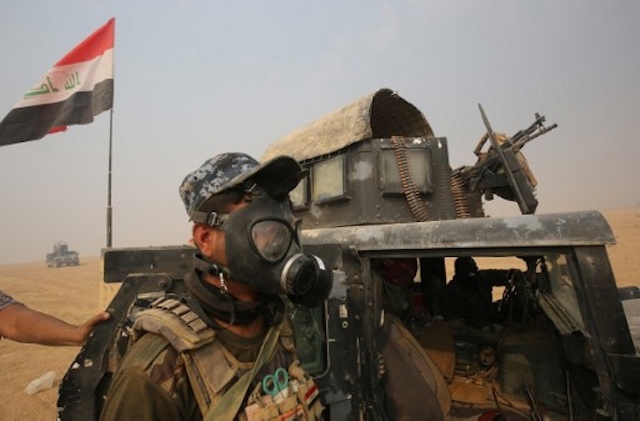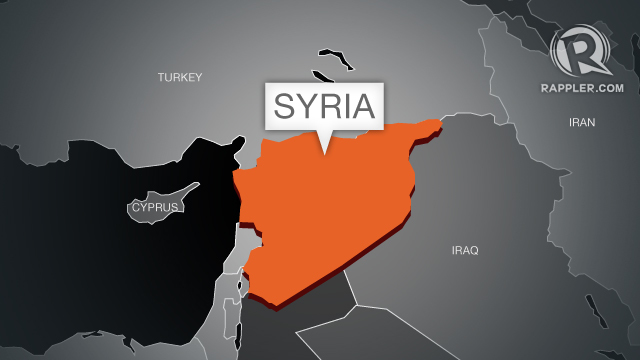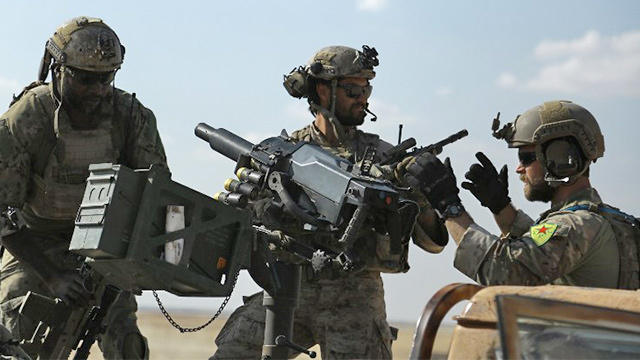Agence France-Presse
Published 7:31 PM, October 25, 2016
(UPDATED) Forces from the elite counter-terrorism service (CTS) retook areas close to the eastern outskirts of Mosul, ISIS’s last major urban stronghold in Iraq
MOSUL CAMPAIGN. Iraqi forces gather in the al-Shura area, south of Mosul, on October 24, 2016, during an operation to retake the main hub city from the Islamic State group jihadists. Photo by Ahmad Al-Rubaye/AFP
QARAQOSH, Iraq (UPDATED) – Iraqi forces were inching to within striking distance of eastern Mosul Tuesday, October 25, as defense chiefs from the US-led coalition met in Paris to review the offensive on the jihadist bastion.
With the Mosul battle in its second week, French President Francois Hollande called for the coalition against the Islamic State group to prepare for the aftermath and the next stages of the war against ISIS.
Forces from the elite counter-terrorism service (CTS) retook areas close to the eastern outskirts of Mosul, ISIS’s last major urban stronghold in Iraq.
“On our front, we have advanced to within five or six kilometers (three to four miles) of Mosul,” their commander, General Abdelghani al-Assadi, told AFP.
“We must now coordinate with forces on other fronts to launch a coordinated” attack on Mosul, he said, speaking from the Christian town of Bartalla.
Kurdish peshmerga forces are making gains on the northeastern front, but federal forces advancing from the south have some way to go before reaching the outskirts.
Meanwhile, thousands of men from the Hashed al-Shaabi paramilitary umbrella group dominated by Tehran-backed Shiite militias were preparing for a push to the west of Mosul.
The Hashed leadership has ordered “us to assume the mission of liberating the Tal Afar district”, said Jawwad al-Tulaibawi, spokesman for the Asaib Ahl al-Haq militia, referring to an area west of the mainly Sunni city.
The Hashed’s mission will be to “cut off and prevent the escape of (ISIS) towards Syria and fully isolate Mosul from Syria”, Tulaibawi told AFP.
Turkey threat
“We expect that it will be a difficult and fierce battle,” he said.
Iraqi Kurds and Sunni Arab politicians have opposed the Hashed’s participation in the operation, as has Turkey, which has a military presence east of Mosul despite repeated demands by Baghdad to withdraw its forces.
Tensions have risen between Baghdad and Ankara, whose foreign minister, Mevlut Cavusoglu, warned Tuesday that if there is a threat to Turkey, “we are ready to use all our resources including a ground operation”.
In Paris, French Defense Minister Jean-Yves Le Drian was meeting coalition counterparts, including Pentagon chief Ashton Carter, to review the war on IS after more than two years of air strikes, training and on-the-ground military advisers.
Besides coordinating their support for the forces closing in on Mosul, ministers will also attempt to iron out differences over priorities in the campaign.
France is keen to tackle the jihadists’ Syria bastion Raqa, where a large number of French foreign fighters in ISIS ranks are stationed.
As the ministers met, Hollande warned that “the recapture is not an end in itself. We must already anticipate the consequences of the fall of Mosul.”
“What is at stake is the political future of the city, the region and Iraq,” Hollande said, calling for “all ethnic and religious groups” to have a say in the future running of Mosul.
Looking to Raqa
He also called on the ministers to set out “the stages of the next operations” against ISIS, namely retaking Raqa.
While the jihadists in Mosul are outnumbered about one to 10, there are insufficient forces currently available to take on the estimated 3,000-4,000 ISIS fighters in Raqa.
Seeking to draw attention away from the Mosul campaign, ISIS has staged attacks in the northern city Kirkuk and western town of Rutba in recent days.
Jihadists seized two neighborhoods in Rutba, but officials said that as of Tuesday it was fully back in government hands.
Senior Iraqi and US military officials have reported that ISIS leaders are already trying to leave Mosul to reach the Syrian side of their “caliphate”.
But a senior official close to Le Drian said a few hundred ISIS fighters recently moved in the opposite direction, reinforcing the estimated 3,000 to 5,000 jihadists defending Mosul.
ISIS had shown increasing pragmatism in recent battles, tending to fall back in the face of superior firepower.
But with its claim to run a “caliphate” losing credibility with every new loss of territory, ISIS has mounted a fierce and well-organised resistance in the fight for Mosul.
Mosul is where ISIS supremo Abu Bakr al-Baghdadi proclaimed the cross-border “caliphate” in June 2014, and its loss could spell the end of the group’s days as a land-holding force in the Iraqi part.
In Moscow Tuesday, Russian Foreign Minister Sergei Lavrov equated US support for Iraqi efforts to recapture Mosul with Russian backing of a Syrian government offensive to seize rebel-held eastern Aleppo. – Rappler.com
Kurdish-Arab forces announce anti-ISIS offensive north of Syria’s Raqa
BEIRUT, Lebanon – A Kurdish-Arab alliance on Tuesday, May 24, announced the launch of a major assault against the Islamic State (ISIS) group north of the Syrian bastion of Raqa.
“With the participation of all SDF (Syrian Democratic Forces) units, we start this operation to liberate northern Raqa” province, the SDF wrote on Twitter, quoting Kurdish commander Rojda Felat.
The push will be supported by air strikes from the US-led coalition bombing ISIS in Iraq and Syria, the SDF said.
The SDF was formed in October as an alliance between the powerful Kurdish People’s Protection Units (YPG) and rebel groups including Arab and Assyrian militias.
It said on Twitter that it would clear ISIS from territory north of Raqa and also secure cities already seized from the jihadists.
But it made no mention of Raqa city itself.
The fresh offensive comes just three days after the highest-ranking US regional commander made a surprise visit to northern Syria.
General Joseph Votel, head of US Central Command (Centcom), met SDF leaders and US military advisors working with Syrian Arab fighters.
He was “in Syria preparing the push to Raqa,” anti-IS coalition chief Brett McGurk tweeted.
The US has roughly 200 advisers on the ground in Syria, but no combat units.
Votel’s visit came as the first of 250 more US special operations forces were beginning to arrive.
According to the Syrian Observatory for Human Rights monitoring group, coalition warplanes on Tuesday carried out dozens of strikes north of Raqa city.
Russian Foreign Minister Sergei Lavrov on Tuesday said Moscow was ready to coordinate with both the US and the SDF in the offensive for Raqa.
The SDF has a total of about 25,000 Kurdish fighters and about 5,000 Arab fighters.
With coalition air support, it has expelled IS from key locations across northern Syria, in the provinces of Aleppo, Raqa, and Hasakeh. – Rappler.com
Syria army thrusts into ISIS bastion province Raqa
SYRIAN TROOPS. This file photo taken on May 25, 2016 shows men in uniform identified by Syrian Democratic forces as US special operations forces as they ride in the back of a pickup truck in the village of Fatisah in the northern Syrian province of Raqa. US special operations forces photographed in Syria wearing the insignia of Kurdish troops considered terrorists by Turkey have been ordered to remove the patches, a military spokesman said May 27, 2016. Ankara accused the United States, a NATO ally, of “unacceptable” behavior for such an overt display of support for the Kurdish People’s Protection Units (YPG). Photo by Delil Souleiman/AFP
BEIRUT, Lebanon – (UPDATED) Syrian troops pushed into the Islamic State in Iraq and Syria group’s (also known as ISIS, IS, ISIL, or Da’esch) bastion province Raqa on Saturday, June 4, 2016, for the first time since 2014, in an advance towards the country’s largest dam, a monitor said.
The Tabqa dam on the Euphrates River, 40 kilometers (25 miles) upstream from Raqa city, is also the target of a separate offensive launched by US-backed Kurdish-led forces advancing from the north late last month.
“Regime troops backed by Russian air strikes and Russian-trained militia entered Raqa province on Saturday morning for the first time since August 2014,” Syrian Observatory for Human Rights director Rami Abdel Rahman told Agence France-Presse (AFP)
The lightning advance from the southwest brought government troops to within less than 40 kilometers (25 miles) of Tabqa, which is also the site of an airbase, Abdel Rahman said.
“It seems there has been an undeclared coordination between Washington and Moscow,” he added, referring to the pincer movement by the two governments’ respective Syria allies.
At least 26 jihadists and nine government troops and militia were killed in the advance, according to the Britain-based Observatory, which relies on reports from medics and activists on the ground.
Tabqa dam has a huge reservoir named Lake Assad after President Bashar al-Assad’s late father and predecessor Hafez.
When IS overran the area in 2014, it summarily executed 160 captured regime troops.
The jihadists are facing counter-attacks on multiple fronts.
Arab and Kurdish fighters backed by Washington have launched an assault on the strategic Manbij pocket further up the Euphrates on the Turkish border, regarded as a key entry point for foreign jihadists.
Hundreds of kilometers (miles) downstream in neighboring Iraq, elite Iraq troops have launched an assault on the emblematic ISOS bastion of Fallujah. – Rappler.com
















![[IN PHOTOS] Star Magic Ball 2016: Who went solo? [IN PHOTOS] Star Magic Ball 2016: Who went solo?](http://images.outbrain.com/Imaginarium/api/uuid/75aab4af46853d08ea0caef9d47004e685405f910463e8806b54a1c4be5cf951/300/200)

![[IN PHOTOS] Star Magic Ball 2015: 15 best dressed [IN PHOTOS] Star Magic Ball 2015: 15 best dressed](http://images.outbrain.com/Imaginarium/api/uuid/988c42a40331da5e1f6f9c753f37f52d413652e51ba1a08f8c00f5078c29faa3/300/200)






















